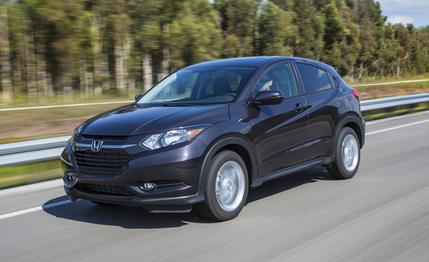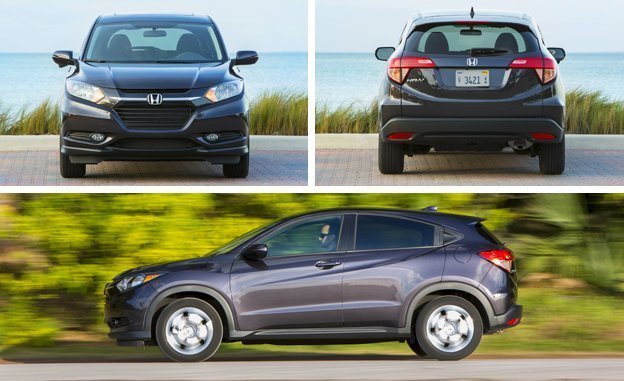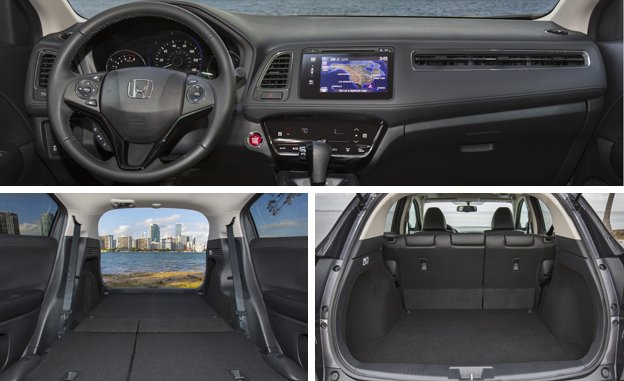
 First Drive Review
First Drive Review
The SUV-ification of the automobile market continues apace, with buyers in even the smallest segment now deciding that they, too, want the higher seating position and (in all-wheel-drive versions) the bad-weather capability afforded by a crossover-type vehicle. Honda is showing more hustle than usual with the new 2016 HR-V, getting into this game in the still-early innings. The Nissan Juke, the Mini Countryman, and the Buick Encore were the pioneers but in the past year the size of the field has more than doubled, with new entrants such as the Chevy Trax, the Jeep Renegade, the Fiat 500X, and the upcoming Mazda CX-3. The HR-V crossover, which slots in below the wildly popular CR-V in size and price, promises to be a strong entrant in this burgeoning field.
Whereas the CR-V is based on the Civic, the HR-V shares its platform with the Fit subcompact. The HR-V, however, is a whole order of magnitude more solid- and substantial-feeling than that waif-like little box. The cabin is much wider, the windshield isn’t miles away, and the interior design and materials are better. If you never looked behind you, you could easily be convinced that this is a new CR-V.


Indeed, the HR-V is substantially larger than the wee Fit. Its wheelbase is longer by 3.2 inches, its front track wider by 2.1 inches, and the rear track is up by 2.6 inches. Overall, the HR-V casts a shadow 9.1 inches longer and 2.8 inches wider than the Fit, and it stands 3.2 inches taller.
Those extra inches, of course, bring with them more weight. Compared to the Fit, the HR-V is nearly 400 pounds heavier by Honda’s measurements. Even so, its curb weight of roughly 3000 pounds is svelte for this class.
In other markets, the HR-V uses the Fit’s 130-hp 1.5-liter four-cylinder, but for the United States Honda wisely bypassed that engine in favor of the larger, 1.8-liter unit from the Civic. Alas, the 1.8-liter’s output isn’t that much greater, mustering 141 horsepower at 6500 rpm and 127 lb-ft of torque at 4300 rpm—figures that are near the bottom of the baby-ute pile. It’s no surprise, then, that the HR-V is slow, with zero-to-60 times likely falling in the nine-to-10-second range. The CVT automatic, which is the only available transmission with AWD, sends revs soaring and keeps them there while one waits for speed to build. (Or one can flap through the paddles, which causes the transmission to run through seven preset ratios.)


Honda offers a six-speed manual in front-wheel-drive LX and EX models, and it provides the sensation of livelier acceleration. We like that the stick is easy to shift, but the clutch travel seems long and the throws a bit ropey. Unfortunately, the manual is at a real disadvantage in fuel economy. According to the EPA, the automatic returns 28/35 mpg with front-wheel drive, beating the manual by 3 mpg in the city and 1 mpg on the highway; the CVT-only AWD model nets ratings of 27/32 mpg. All of those figures are at or near the top of the class.
On our straight, flat, and traffic-choked drive route in South Florida, the HR-V didn’t display much verve for cornering—although it didn’t have much opportunity to do so beyond an aggressively taken on-ramp or two. The HR-V’s electric power-steering system, though, does offer reasonable effort, and the suspension capably soaks up road irregularities.
The HR-V’s real talents lie elsewhere—chiefly in its people- and cargo-carrying capacity. Packaging has long been a Honda forte, and it’s definitely on display here. The HR-V follows the Fit’s lead in cleverly placing the fuel tank under the front seats, which allows the rear seat cushion to flip up, creating a practical space for ferrying taller objects. Alternately, the split rear seatbacks can flop forward, as can the front passenger seatback. Even when it’s not showing off its gymnastic flexibility, the HR-V boasts the largest cargo hold among its peers, whether that’s behind the rear seats or with that row folded. And the extremely low cargo floor facilitates easy loading, a boon for those who frequently haul heavy items.